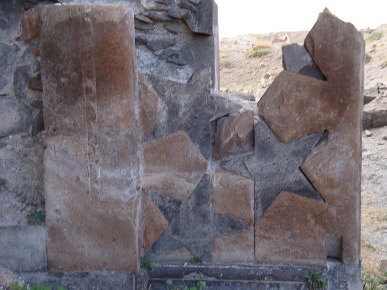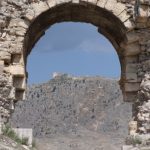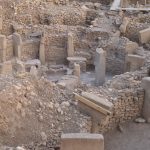Bagratid Armenia’s splendid abandoned capital
Set on a headland above the valley of the Arpa Çayı river right on the border with Armenia, the ruins of Ani, just outside the village of Ocaklı, 45km east of Kars, make up one of the most romantic sights in Turkey, and the sensitivity of their location has ensured that no ugly development has been allowed to sprout in the vicinity.
*If time is tight, the southern side of the site is the most interesting.*
Backstory
The modern border may have left Ani stranded on the Turkish side but it was as the capital of the medieval Bagratid Kingdom of Armenia that it experienced its glory days.
This kingdom originally had its capital in Kars but in the 10th century King Ashot III decided to move it to this new location which was closer to the main trade routes. The city flourished for almost a century, the area inside its fine chequerboard-patterned stone walls filling up with fine churches. Then in 1045 the Byzantines seized it, losing it again in 1064 to the Selçuks who established a palace here.
From then on rulers came and went in quick succession until in 1239 the Mongols drove everyone else out. In 1319 an earthquake toppled many of the fine buildings and the history of Ani effectively came to an end.
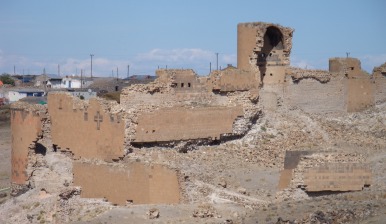 Around the site
Around the site
The ticket booth sits right beside the huge city walls that will remind some visitors of those surrounding Welsh castles.
Once through the Aslan Kapısı, a gate named either after the Selçuk leader Alp Arslan who conquered Ani in 1064 or more prosaically after the lion carving above it, you will realise that the interior is a vast empty space dotted with the remains of stone-built churches, a cathedral, a mosque and a palace. Presumably most of the houses were made of wood and didn’t survive.
If you turn left inside the gate and start walking round the site in a clockwise direction the first major sight you will come to is the remains of the Church of the Redeemer (St Prkitch), built between 1034 and 1036 and half destroyed by a lightning bolt in 1957. It is thought to have housed a piece of the True Cross brought here from Constantinople (İstanbul). 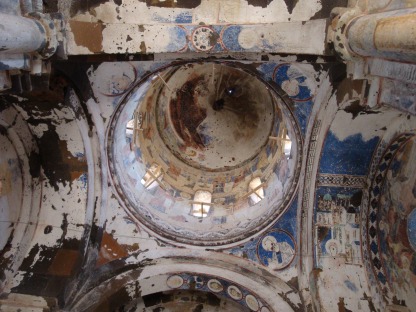
A little further round and down in a dip you will come to one of Ani’s most magnificent sights, the frescoed Church of St Gregory the Illuminator, known as the Resimli Kilise (Painted Church) in Turkish. It was paid for by Tigran Honentz, a local nobleman, in 1215 and the entire surface of the interior and the dome is lavishly painted with images of Bible stories and events from Armenian church history.
Continuing in a clockwise direction if you look down towards the Arpa Çayı you will see one of the prettiest of Ani’s ruins, the delicate 13th-century Convent of the Virgins (Kusanats). Its proximity to the border means that you can only admire it from above.
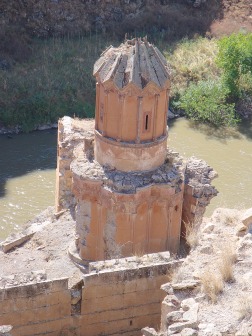 You now need to cut a little inland to reach the ruins of the cathedral that was built between 987 and 1010. In comparison with the Convent of the Virgins it’s a gaunt rectangle of a building, the central dome having long since caved in. It was accessed, unusually, via a door in the south rather than the west wall. Trdat Mendet, the architect responsible for the cathedral, was also employed to repair Hagia Sophia in Constantinople after it was damaged by an earthquake.
You now need to cut a little inland to reach the ruins of the cathedral that was built between 987 and 1010. In comparison with the Convent of the Virgins it’s a gaunt rectangle of a building, the central dome having long since caved in. It was accessed, unusually, via a door in the south rather than the west wall. Trdat Mendet, the architect responsible for the cathedral, was also employed to repair Hagia Sophia in Constantinople after it was damaged by an earthquake.
After the Selçuk conquest the cathedral was converted into the Fethiye (Conquest) Cami.
Heading west from the cathedral you will come to an area of less dramatic ruins that are nonetheless very evocative since they suggest the ordinary life of Ani. Here a stretch of street with the remains of shops on either side has been excavated.
At the far end are the remains of the Selçuk Menücehir Cami (1072) with a minaret that looks rather like a factory chimney. Some historians argue that this was originally a palace. The remains of houses and a granary have been uncovered across the road from it.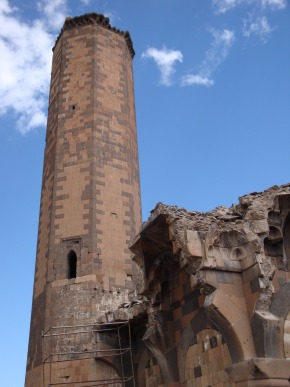
If you keep walking past the remains of the houses you will come to the İç Kale (Keep) which may or may not be accessible, depending on the men in charge when you visit.
Then if you keep on walking clockwise you will come to the remains of the Church of St Gregory (Abughamrentz), a 12-sided structure, built in 1040, that offers a fine view towards a rock-cut settlement on the far side of the river.
Next you will come to the Church of the Holy Apostles, built in 1031 but converted by the Selçuks into a caravanserai in 1064. Northwest of this church the Church of St Gregory (Gagik I), built in 998 by the same Trdat Mendet who designed the cathedral, is almost completely ruined.
Finally, you may not want to bother diverting to inspect the remains of the Selçuk Palace that was so badly restored that it now looks like a toilet block with an elaborately decorated entrance inserted into the front wall. Most people would regard it as Ani’s shame.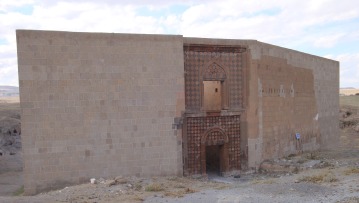
Restoration work has led to the introduction of some rather unsightly bright-red support structures around the site. Restoration of the Church of St Gregory the Illuminator is likely to be ongoing for many years.
Sleeping
There is nowhere to stay at Ani. You will need to overnight in Kars.
Transport info
Would-be guides and taxi drivers visit Kars hotels in search of customers. Should they fail to find you, ask the receptionist or the local tourist office to help you find them.
Day trip destinations
Mağazbert Kalesi (not currently accessible to visitors)
